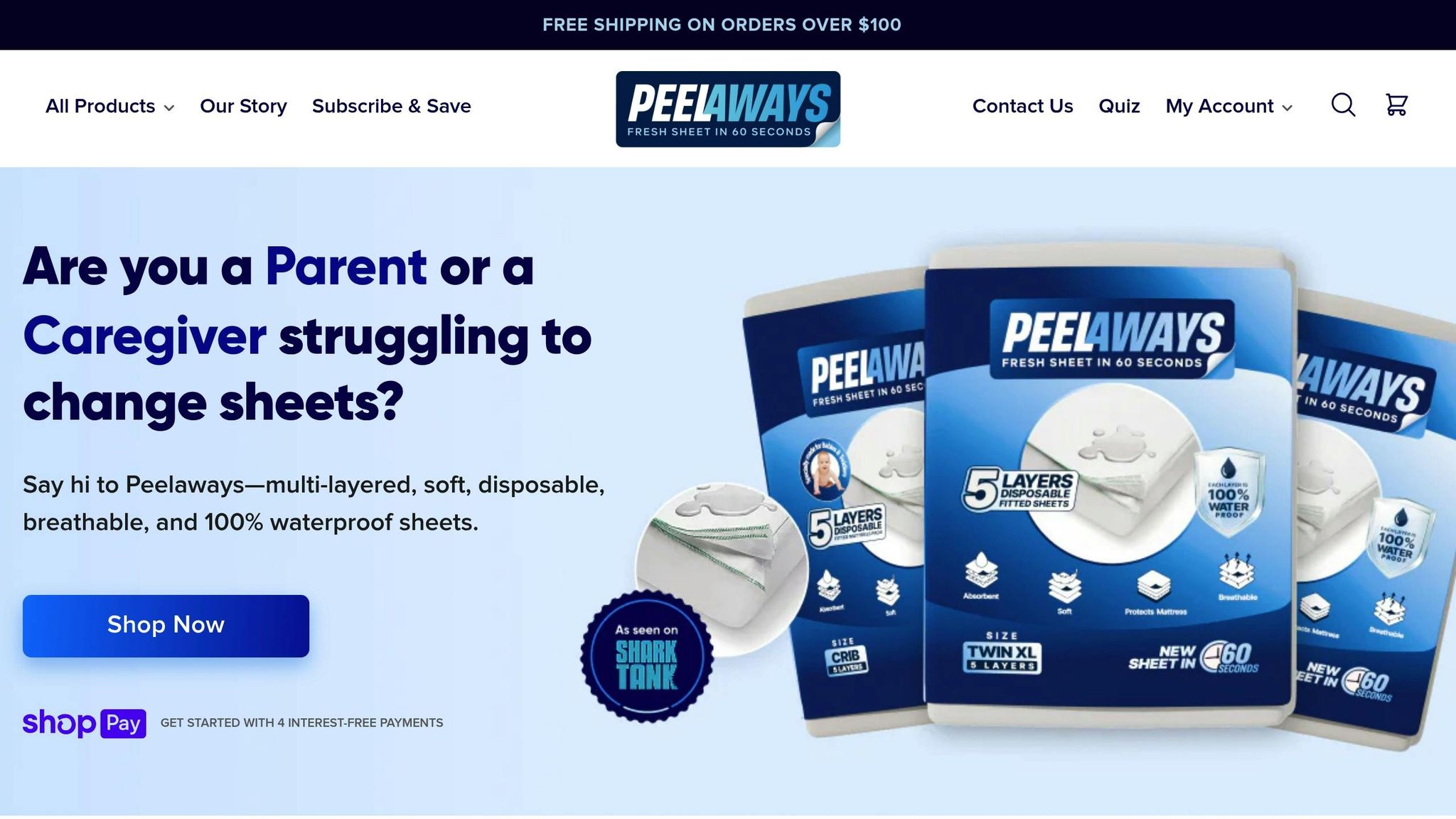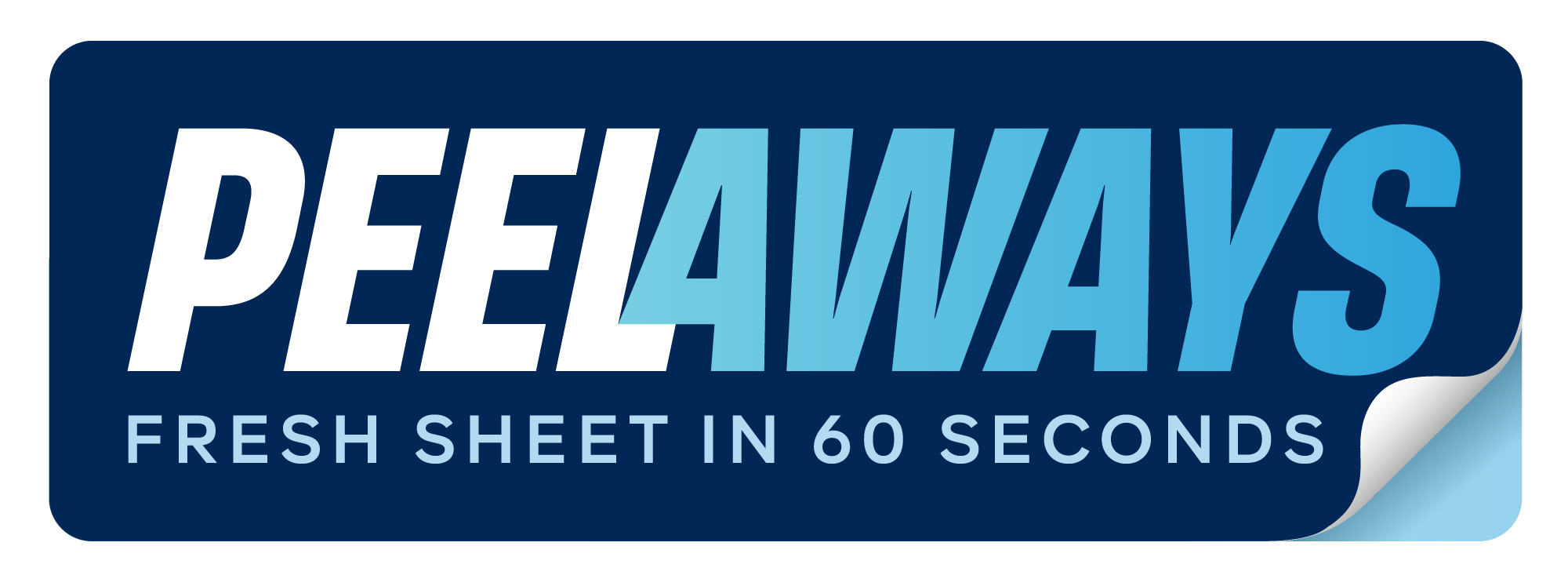How to Keep Beds Dry During Incontinence Care

Managing incontinence can be tough, but keeping beds dry is achievable with the right tools and setup. Here's what works:
- Waterproof Mattress Protectors: Shields mattresses from moisture and odors. Look for breathable, snug-fitting options with terry cloth tops for added comfort.
- Disposable Waterproof Sheets: Ideal for convenience. Products like PeelAways offer multi-layer designs, letting you peel off soiled layers without lifting the mattress. Prices range from $30.99 (Crib) to $53.99 (King).
- Reusable Bed Pads: Durable, washable pads with waterproof backings hold 2–4 cups of liquid. Rinse promptly after use and avoid fabric softeners to maintain absorbency.
- Layering Bedding: Combine waterproof protectors, reusable pads, and disposable sheets for quick changes. Keep spare supplies nearby for easy access.
Dry bedding not only simplifies care but also protects skin health by preventing irritation and pressure sores. Use soft, breathable materials and ensure proper airflow to avoid overheating. Pair these solutions with a consistent routine for better sleep and comfort.
Disposable Bed Sheet | Incontinence Bed Pad | Peelaways on QVC

Selecting the Right Bedding Products
When it comes to bedding, it's important to find products that keep moisture at bay while staying comfortable and easy to use for both caregivers and care recipients.
Waterproof Mattress Protectors
A waterproof mattress protector is your first line of defense against moisture. It not only shields the mattress from damage but also helps prevent odors from building up over time, saving you from costly replacements.
For the best results, look for protectors with breathable membranes. These block liquids while allowing airflow, avoiding that stiff, plastic-like feel that can make sleep uncomfortable. A well-designed protector fits snugly around the mattress, like a fitted sheet, and stays in place without sliding or bunching during the night.
If comfort is a priority, consider protectors with terry cloth tops. They feel softer against the skin, absorb moisture effectively, and wick it away from the body. And since hygiene is key, make sure the protector is machine washable and dryer-safe for easy maintenance.
Disposable Waterproof Sheets
Disposable waterproof sheets are a game-changer when it comes to convenience. They eliminate the need to wash soiled bedding, offering a hassle-free solution. A standout option is PeelAways, which features a patented multi-layer design with 5 to 7 absorbent layers. After an incident, simply peel off the top layer to reveal a clean one underneath - no mattress lifting, no laundry, and no risk of cross-contamination.
PeelAways come in a variety of sizes to suit different needs. For example, Crib-A-Peel for toddlers costs $30.99, while a King size option is priced at $53.99. The Twin XL with 7 layers costs $41.99, making it particularly practical for hospital or adjustable beds used in elder care. These sheets combine 100% waterproof protection with a soft, breathable fabric that feels far from clinical.
Made with chemical-free materials, they’re safe for sensitive skin. Plus, compostable and biodegradable options are available, addressing concerns about waste. For families managing long-term care, the ease of use and time saved make disposable sheets a worthwhile choice, especially during demanding times.
Reusable Bed Pads
Reusable bed pads offer an extra layer of protection for areas prone to accidents. Look for pads with a four-layer design: a soft top layer, an absorbent core, and a waterproof backing that can hold 2–4 cups of liquid without leaking.
To extend the life of reusable pads, rinse them immediately in cold water after use, then wash with warm water and enzyme-based detergents to break down organic material. Skip fabric softeners, as they can reduce absorbency, and air dry the pads to preserve the waterproof backing.
For added security, choose pads with features like tuck-in flaps, grip strips, or adhesive corners. These keep the pads in place, preventing uncomfortable bunching or gaps in protection - especially helpful for active sleepers.
Having multiple pads in rotation can also make life easier. While one is being washed, you’ll always have a clean one ready to go. This setup is particularly useful for families who prefer reusable solutions but need reliable, consistent protection.
Setting Up Daily Bed Care Routines
Once you've chosen the right products, establishing a daily routine with regular inspections and thoughtful layering can enhance comfort and reduce disruptions.
Regular Checks and Bedding Changes
Frequent checks are key to catching moisture early and avoiding skin irritation. During each inspection, focus on areas where your care recipient spends the most time, looking for any damp spots. Disposable bedding can make quick changes easier, ensuring a fresh start to the day. Dry bedding not only helps prevent odors but also shows that care is being attentively managed. Pair these inspections with a smart layering system to simplify nighttime care.
Layering Bedding for Easy Changes
Layering bedding strategically can make overnight changes quicker and less intrusive. Start with a zippered waterproof mattress encasement, followed by a snug waterproof protector. Add a large, durable washable pad over the fitted sheet, and top it off with a disposable underpad or PeelAways for added convenience.
For extra coverage, you can double up: place a waterproof mattress pad first, then a fitted sheet, and add another layer if necessary. Instead of using one heavy comforter, opt for multiple lightweight blankets. This way, you can remove only the affected layers during an accident, minimizing disruption.
Keep spare sheets, pads, blankets, and fresh nightclothes within easy reach. Using clear containers for storage makes it simple to locate items, even in low light. A small bedside light can also be helpful during nighttime changes. Additionally, having a quick-change kit stocked with cleaning supplies and disposal bags can save time and effort.
The National Association for Continence highlights the value of layering:
"And remember, layers are your friend. They will help keep any leaks to a minimum and make clean up so much easier."[1]
sbb-itb-45288fe
Maintaining Comfort and Skin Health
Selecting the right bedding materials isn't just about moisture protection - it also plays a crucial role in preventing overheating and skin irritation.
Breathable and Gentle Materials
Soft, breathable fabrics are essential for ensuring comfort, particularly for sensitive skin. When shopping for bedding, prioritize materials that feel gentle to the touch but still offer waterproof protection. Older waterproof products often relied on stiff, crinkly plastic backings that could be uncomfortable. Fortunately, modern designs focus on creating a softer, more pleasant experience.
For those with delicate or aging skin, hypoallergenic and chemical-free fabrics are especially important. These materials help reduce the risk of irritation, making them ideal for individuals with compromised skin health. Some advanced bedding products combine waterproof features with soft, chemical-free fabrics, offering both protection and comfort.
Scratchy or rough materials can cause discomfort and even contribute to pressure sores. To avoid this, look for bedding with a top layer that feels like regular sheets rather than something overly clinical. This not only enhances comfort but also helps maintain dignity.
Another key feature to consider is an absorbent top layer. These layers wick moisture away from the skin, keeping it dry and preventing that damp, uncomfortable feeling. This can also reduce the risk of skin maceration, which occurs when prolonged moisture weakens the skin.
While softness and moisture absorption are crucial, keeping the body at a comfortable temperature is just as important.
Preventing Overheating
Waterproof bedding can sometimes trap heat, leading to discomfort and excessive sweating. However, modern designs have tackled this issue with improved airflow and temperature regulation.
Look for bedding that incorporates airflow features to promote circulation while maintaining its protective barrier. This prevents the stuffy, overheated sensation often associated with traditional waterproof materials.
Bedding with multiple thin layers is another great option. These layers allow for better air movement compared to a single, thick barrier. Plus, when an accident happens, you can remove just the top layer, minimizing disruption and improving temperature control.
Room temperature adjustments can also help. Keep the bedroom slightly cooler - around 65-68°F - to counteract any extra warmth from waterproof layers. A small fan can further enhance air circulation without creating uncomfortable drafts.
Lightweight, breathable bedding is preferable to heavy blankets, as it allows for better temperature control. Using several light layers instead of one heavy layer gives you the flexibility to adjust throughout the night.
Pairing breathable bedding with moisture-wicking pajamas can make a big difference. Natural fibers like cotton or bamboo are excellent choices for sleepwear, as they draw moisture away from the skin. Avoid synthetic materials, which are more likely to trap heat and cause discomfort.
Making Incontinence Care Easier with Proper Bedding
Incontinence care becomes much more manageable with the right bedding. By choosing high-quality waterproof and disposable options, caregivers can simplify daily routines and cut down on time-consuming cleanups.
Take disposable waterproof sheets like PeelAways, for example. Their peel-away design allows you to reveal a fresh, clean layer in seconds - no need to lift the mattress or deal with endless laundry. This feature is especially helpful in healthcare settings or homes with multiple family members, as it also helps reduce the risk of cross-contamination.
These disposable sheets are also budget-friendly. They come at competitive prices, helping families save money on cleaning supplies and mattress replacements. Plus, by making accidents easier to manage, they allow caregivers and care recipients to focus more on comfort and less on constant disruptions.
Modern designs don’t just stop at functionality - they also prioritize comfort. Many disposable bedding options use soft, skin-friendly materials while still offering a reliable barrier against moisture, making them suitable even for sensitive skin.
For families dealing with long-term care, these bedding solutions are incredibly versatile. They come in various sizes, from crib sheets for potty training toddlers to King-sized options for adults, ensuring consistent protection for any sleeping arrangement. And with a 30-day money-back guarantee, transitioning to these convenient options feels less daunting.
FAQs
What’s the best type of bedding for managing incontinence?
Choosing bedding for incontinence care depends on what works best for your situation. Disposable bedding stands out for its ease of use and hygiene. It’s designed to handle moisture effectively, minimize skin irritation, and save time by eliminating washing - making it a great choice for caregivers or anyone needing frequent changes.
If you’re looking for a more sustainable and cost-effective option, reusable bedding might be the way to go. It’s often more comfortable and suits individuals with lighter incontinence or those aiming to cut down on waste.
For a mix of practicality and innovation, check out products like Peelaways. These feature multiple layers that you can peel off as needed, keeping the bed clean and dry without the hassle of constant laundering.
How can I care for reusable bed pads to keep them effective and long-lasting?
To keep reusable bed pads absorbent and long-lasting, wash them in cold or warm water with a mild, fragrance-free detergent. Steer clear of bleach and fabric softeners, as these can weaken the fabric and diminish their absorbency. Dry them on low heat or let them air dry to minimize wear and maintain their performance.
Taking these steps will help your reusable bed pads stay effective and dependable for a longer period.
How can I keep waterproof bedding comfortable and cool for better sleep?
When choosing waterproof bedding, prioritize materials like cotton, bamboo, or Tencel. These fabrics are breathable, promote airflow, and help wick away moisture, keeping your bed cool and comfortable throughout the night.
Steer clear of bedding made with plastic or vinyl layers. While they may be effective at repelling water, they often trap heat, leading to an uncomfortable sleeping experience. If overheating is an issue, look into options specifically designed for temperature regulation, such as cooling mattress pads or breathable sheets. These simple adjustments can go a long way in creating a more relaxing and restful sleep environment.
Related Blog Posts
- 7 Tips for Preventing Skin Irritation from Incontinence
- Why Organic Waterproof Bedding Matters for Incontinence Care
- How to Choose Bedding for Incontinence Care
- Common Bedding Problems in Elderly Care
Comments
0

SAVE MONEY & WATER
Professionals & Institutions save a fortune on labor/laundry.

SUPERIOR COMFORT
The first thing our customers notice is how soft our sheets are.

100% WATERPROOF
Each layer is 100% Waterproof, perfect for spills and accidents

SAVE TIME
Change the sheet in under 1 minute without stripping the bed.




Leave a comment